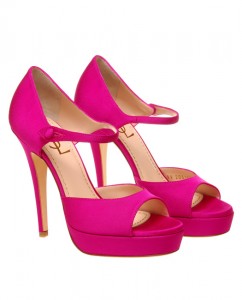Guest Post by Kitty Holman
Make no mistake, there are some women who absolutely love to shop. And why not? Shopping has long been described as being a therapeutic activity because it has the uncanny ability to lift the spirit. After all, bringing home a new pair of sassy shoes can do wonders for a foul mood. But shopping can also be a detrimental hobby for women who are carefully monitoring their funds. This is especially true during the week right before menstruation. New research by Karen J. Pine and Ben C. Fletcher at the University of Hertfordshrine’s School of Psychology has shown that women tend to spend more money when they are later into their menstruation cycle than during any other time of the month. Their paper, “Women’s spending behaviour is menstrual-cycle sensitive,” appears in the January, 2011, issue of Personality and Individual Differences.
Menstruation affects women in an almost primal way. At peak ovulation, which is when the female body is the most fertile and therefore the most likely to become pregnant, women may find themselves unconsciously adapting their behavior to attract men, or potential mates. Many women change their dress style during this time in an effort to impress potential partners, which has been dubbed the “ornamentation effect,” according to researchers . The ornamentation effect typically occurs a week before menstruation, coinciding with Pine and Fletcher’s findings that women tend to make more indulgent and reckless expenditures during this time than any other time of the month. The research suggests that the two are connected, as women may make more self-indulgent purchases, typically of clothing or other “preening” items, because they are unconsciously driven to adapt their physical appearance to attract a mate. In fact, the researchers surveyed 443 women, all menstruating and between the ages of 18 and 50, and found that 48 percent of the women who admitted to impulsive and excessive spending did so when they were premenstrual, as opposed to the 34 percent who were menstrual or post-menstrual and the mere 18 percent who were in mid-cycle.
Another factor driving women to overspend a week before menstruation can be attributed to hormones. Immediately before menstruation, the female body is barraged with different signals in addition to the desire to attract a potential partner. Hormonal triggers can bring on mood swings and other irritability symptoms associated with premenstrual syndrome, also known as PMS. These symptoms and the stress that they bring on can dampen a woman’s capacity for self-control, which can further explain why women tend to spend more during the luteal phase, the only time during the menstrual cycle when PMS occurs. If the unawareness of self-control is not one of the driving causes behind overspending during the luteal phase, then it is likely that justification is. Women may feel that they deserve to spend more during this time of the month as they are generally feeling uncomfortable and irritable, even if they understand that the expenditure is extravagant.
Whether excessive spending is caused by an unconscious need to preen, a lack of self-control in the face of PMS-related stress, or a simple license to indulge in shopping caused by luteal phase anxiety, otherwise money-smart women can find themselves more susceptible to making impulse purchases the later they are into their menstrual cycle. Those who wish to watch their spending and protect their funds from reckless behavior can simply avoid the mall during that particular time of the month.
This guest post is contributed by Kitty Holman, who writes on the topics of nursing schools. She welcomes your comments at her email address kitty.holman20@gmail.com



I’m kind of suspicious of this. I mean, last time I checked, I didn’t start craving shopping or “ornamenting” (I’m not a Christmas tree, after all) a week before my period. None of my female friends do, either. Isn’t this more of a socialization thing than a science thing?
I completely agree with Charlotte. Furthermore, I wonder how exactly these “researchers” went about gathering their information. If they gave the women a survey, asking them to recall their shopping habits in relation to their cycle, they would be much more likely to “admit” to spending more during “P.M.S.”, giving the surveyors the answer they want which is more typical of a study in which the subjects are not blind to the subject of research. I personally think this is just another way for society, particularly men, to use the menstrual cycle to define women as “the other”, putting effort into figuring out more ways in which women may be the less capable of functioning “normally.” I wonder (but doubt) if these same surveyors studied the affects of testosterone levels on male consumption.